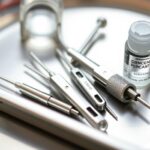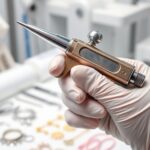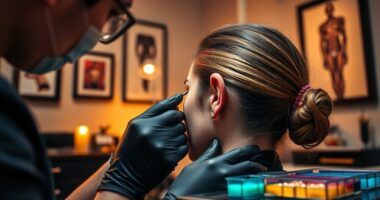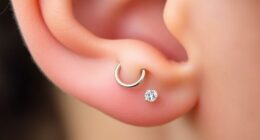To sterilize tools to hospital standards, you should conduct regular autoclave audits. This involves verifying the equipment reaches the correct temperature, pressure, and cycle duration, while reviewing sterilization records and indicators. Proper maintenance and calibration are essential for consistent results. Regular checks help you catch issues early and ensure safety. If you keep exploring, you’ll discover how to implement effective audit procedures that guarantee high-quality sterilization standards.
Key Takeaways
- Regular autoclave audits verify proper temperature, pressure, and cycle duration to meet hospital sterilization standards.
- Inspection of sterilization indicators and biological testing confirm effective pathogen elimination.
- Maintenance and calibration ensure autoclaves operate accurately and consistently at optimal performance levels.
- Detailed record-keeping of sterilization cycles demonstrates compliance and facilitates ongoing performance monitoring.
- Routine reviews help studios identify issues early, prevent contamination, and uphold safety standards comparable to hospitals.

Have you ever wondered whether your autoclave is operating at peak efficiency and guaranteeing sterilization safety? It’s a critical question because the integrity of your sterilization procedures directly impacts the safety of your clients and the quality of your work. Regular autoclave audits help verify that your sterilization equipment meets the rigorous compliance standards set by health and safety authorities. These audits are essential to identify any issues that could compromise sterilization, such as improperly functioning gauges, inadequate cycle parameters, or contaminated instruments that escape proper sterilization. By systematically reviewing your autoclave’s performance, you guarantee that every tool you sterilize is genuinely free of pathogens, reducing risks of infection or cross-contamination.
Ensuring autoclave efficiency safeguards client safety and sterilization integrity through regular performance reviews.
During an autoclave audit, you’ll focus on verifying that your sterilization procedures align with established compliance standards. This involves checking that your autoclave reaches the necessary temperature, pressure, and cycle duration for effective sterilization. You need to confirm that your sterilization cycles are correctly calibrated and that the cycle parameters are consistently maintained. This process often includes reviewing records of previous cycles, inspecting sterilization indicators, and conducting biological or chemical testing when necessary. These steps help you determine whether your autoclave is fulfilling its role and adheres to the strict standards required in medical, laboratory, or professional studio environments. Additionally, understanding the importance of contrast ratio in imaging devices underscores the need for precise calibration to ensure optimal performance.
Keeping your autoclave in prime condition isn’t just about following protocols; it’s about guaranteeing safety and maintaining reputation. During an audit, you’ll also assess the maintenance schedule, checking for signs of wear or malfunction that could impair sterilization. Proper maintenance, including routine cleaning and calibration, plays a crucial role in compliance. If issues are identified, you should promptly address them, whether by repairing faulty parts or recalibrating controls. Regular audits, combined with strict adherence to sterilization procedures, help you catch potential problems early, avoiding costly failures or safety breaches down the line.
Ultimately, an autoclave audit isn’t a one-time task. It’s an ongoing process that guarantees your sterilization procedures are reliable and compliant with industry standards. When you approach audits proactively, you’re not only protecting your clients and staff but also demonstrating your commitment to quality and safety. Guaranteeing your autoclave operates efficiently means peace of mind, knowing that every item sterilized in your studio or facility meets hospital-grade standards for safety and hygiene.
Frequently Asked Questions
How Often Should Autoclaves Be Calibrated?
You should calibrate your autoclave regularly to guarantee proper sterilization, typically following the manufacturer’s recommendations. Calibration frequency depends on usage, but generally, it’s advisable to perform it at least once a year or after any repairs or malfunctions. Consistent autoclave maintenance helps prevent issues, ensures reliable sterilization, and maintains compliance with health standards. Keep detailed records of calibration and maintenance to track performance and address potential problems proactively.
What Are Common Autoclave Malfunctions?
Did you know that over 25% of autoclave malfunctions go unnoticed without proper maintenance? Common issues include faulty door seals, which can compromise sterilization, and temperature or pressure errors, leading to ineffective sterilization. Regular autoclave maintenance and using sterilization indicators can help catch these problems early. Keep an eye on these malfunctions to make certain your sterilization process remains reliable and compliant with hospital standards.
Are There Specific Training Requirements for Staff?
You need to guarantee staff training meets certification requirements for sterilization procedures. Proper training teaches you how to operate autoclaves safely and effectively, reducing the risk of malfunctions or contamination. Certification requirements vary by region, but they typically include hands-on practice and knowledge assessments. By completing this training, you stay compliant with safety standards and guarantee tools are sterilized correctly, maintaining a safe environment for everyone.
How Is Sterilization Effectiveness Verified?
Imagine your tools whisper secrets of cleanliness—how do you truly know they’re sterile? You verify sterilization effectiveness through biological indicators, which serve as the gold standard in sterilization validation. These indicators contain spores that are resistant to sterilization; if they’re killed, you’re assured of proper sterilization. Regular testing with biological indicators confirms your autoclave’s performance, ensuring your tools meet hospital standards and safety is never compromised.
What Are the Legal Penalties for Non-Compliance?
You need to understand that non-compliance with sterilization standards can lead to serious legal consequences. Penalty enforcement varies by jurisdiction but often includes hefty fines, license suspension, or even criminal charges. These penalties aim to guarantee safety and compliance. Ignoring sterilization protocols risks not only health violations but also severe legal repercussions, so it’s vital you adhere to all regulations to avoid costly penalties and maintain professional integrity.
Conclusion
Regular autoclave audits ensure your studio sterilizes tools to hospital standards, protecting clients and staff alike. Did you know that improper sterilization can lead to infections in just 2% of cases? By maintaining rigorous standards, you not only safeguard health but also boost your reputation. Stay diligent with your autoclave checks—your clients trust you with their safety, and consistent audits prove you’re committed to excellence. Keep sterilizing right, and stay ahead in quality care.
















